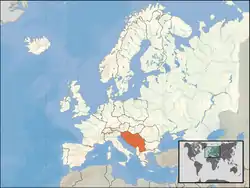Socialist Federal Republic of Yugoslavia
The Socialist Federal Republic of Yugoslavia was the Yugoslav state that existed from the second half of World War II (1943) until it was formally dissolved in 1992 (de facto dissolved in 1991 with no leaders representing it) amid the Yugoslav wars. It was a socialist state and a federation made up of Bosnia and Herzegovina, Croatia, Macedonia, Montenegro, Serbia, and Slovenia.
Socialist Federal Republic of Yugoslavia Socijalistička Federativna Republika Jugoslavijaa Социјалистичка Федеративна Република Југославијаb Socialistična federativna republika Jugoslavija | |||||||||||||||||||
|---|---|---|---|---|---|---|---|---|---|---|---|---|---|---|---|---|---|---|---|
| 1943–1992 | |||||||||||||||||||
.svg.png.webp) Flag
.svg.png.webp) Coat of arms
| |||||||||||||||||||
| Motto: Bratstvo i jedinstvo "Brotherhood and Unity" | |||||||||||||||||||
| Anthem: "Hej, Slaveni" "Hey, Slavs" | |||||||||||||||||||
 | |||||||||||||||||||
| Capital | Belgrade | ||||||||||||||||||
| Common languages | Serbo-Croatian, Slovene, and Macedonian | ||||||||||||||||||
| Government | Federal socialist republic, Single-party socialist state | ||||||||||||||||||
| President | |||||||||||||||||||
• 1945 - 1953 (first) | Ivan Ribar | ||||||||||||||||||
• 1953 - 1980 | Josip Broz Tito | ||||||||||||||||||
• 1991 - 1992 (last) | Stjepan Mesić | ||||||||||||||||||
| Prime Minister | |||||||||||||||||||
• 1945 - 1953 (first) | Josip Broz Tito | ||||||||||||||||||
• 1989 - 1991 (last) | Ante Marković | ||||||||||||||||||
| Historical era | Cold War | ||||||||||||||||||
• Proclamation | November 29 1943 | ||||||||||||||||||
• UN membership | 24 October 1945 | ||||||||||||||||||
• Constitutional reform | 21 February 1974 | ||||||||||||||||||
| 25 June 1991 - 27 April 1992 1992 | |||||||||||||||||||
| Area | |||||||||||||||||||
| July 1989 | 255,804 km2 (98,766 sq mi) | ||||||||||||||||||
| Population | |||||||||||||||||||
• July 1989 | 23724919 | ||||||||||||||||||
| Currency | Yugoslav dinar | ||||||||||||||||||
| Time zone | UTC+1 | ||||||||||||||||||
| Calling code | 38 | ||||||||||||||||||
| |||||||||||||||||||
a Native state name in Latin script. In SFR Yugoslavia, Latin script was used by the Serbo-Croatian language (in SR Croatia and SR Bosnia and Herzegovina), and the Slovene language (in SR Slovenia). After the dissolution of Yugoslavia, the unified Serbo-Croatian language gave way to four new languages: Croatian, Bosnian, Montenegrin and Serbian. Croatian and Bosnian languages consequently use Latin script, while Serbian uses Cyrillic script. Much like Slovene, the Macedonian language (which also uses Cyrillic script) was independent from Serbo-Croatian during (and after) the Yugoslav period. Identical spelling is used in both the Latin and Cyrillic versions of the state name, and in all five ex-Yugoslav languages, with the slight exception of the Slovene language. The Slovene term for the adjective "Socialist" is "Socialistična", instead of "Socijalistička". The spelling in the Serbian and Macedonian Cyrillic script transliterations of the state name (which use the Serbian Cyrillic variant) are identical to the Latin transliteration. b Native State name in Cyrillic script (Serbian Cyrillic variant). In SFR Yugoslavia, Cyrillic script was used as an alternative to Latin by the Serbo-Croatian language (in SR Serbia and SR Montenegro), and the Macedonian language (in SR Macedonia). After the dissolution of Yugoslavia and the unified Serbo-Croatian language, the new Serbian language primarily uses Cyrillic script (alongside Latin). The Macedonian language language, independent during (and after) the Yugoslav period, also continued to use Cyrillic script. | |||||||||||||||||||
Josip Broz Tito ruled Yugoslavia until 1980 when he died. In June 1991 Slovenia and Croatia declared independence. By 1992, only two states still wanted a union, Serbia and Montenegro. They formed the Federal Republic of Yugoslavia, which was not recognized as the successor of the SFRY by international leaders.
This article is issued from Wikipedia. The text is licensed under Creative Commons - Attribution - Sharealike. Additional terms may apply for the media files.